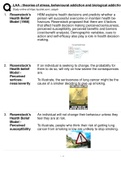LAA : theories of stress, behavioural addiction and biological addiction
Study online at https://quizlet.com/_actgxh
1. Rosenstock's HBM explains health decisions and predicts whether a
Health Belief person will successful overcome or maintain health be-
Model (1966) haviours. Rosenstock proposed that there are 4 factors
that affect health decision making: perceived seriousness,
perceived susceptibility, perceived benefits and barriers
(cost-benefit analysis). Demographic variables, cues to
action and self-efficacy also play a role in health decision
making.
2. Rosenstock's If an individual is seeking to change, the probability for
Health-belief them to do so, will rely on how severe the consequences
Model - are.
Perceived
serious- To illustrate, the seriousness of lung cancer might be the
ness/severity cause of a smoker deciding to give up smoking.
3. Rosenstock's An individual will not change their behaviour unless they
Health Belief feel they are at risk.
Model -
Perceived To illustrate, people who think their risk of getting lung
susceptibility cancer from smoking is low are unlikely to stop smoking.
, LAA : theories of stress, behavioural addiction and biological addiction
Study online at https://quizlet.com/_actgxh
4. Rosenstock's People will consider the cost and benefits of making health
Health Belief changes (cost-benefit analysis).
Model - Benefits- changing behaviour has positive outcomes.
Perceived Costs - disadvantages of behavioural change that prevent
benefits people from acting.
For example, a person is more likely to stop smoking if it
benefits them, such as being able to save money. Irritability
is a cost of quitting.
5. Rosenstock's This refers to a person's feelings on the obstacles to
Health Belief performing a recommended health action.
Model -
Perceived There is wide variation in a person's feelings of barriers,
barriers or impediments, which lead to a cost/benefit analysis. The
person weighs the effectiveness of the actions against the
perceptions that it may be expensive, dangerous (e.g.,
side effects), unpleasant (e.g., painful), time-consuming,
or inconvenient.
To illustrate, the cost of nicotine replacement therapy can
be a barrier. In stressful situations, smoking may provide
relief of stress. If everyone else in a person's peer group
smokes, they may feel socially excluded if they try to give
up.
6. Rosenstock's Demographic variables (such as age, gender, ethnicity,
Health Belief culture, education level) are individual differences, that
Model - can impact a person's health- related decisions.
, LAA : theories of stress, behavioural addiction and biological addiction
Study online at https://quizlet.com/_actgxh
Demographic
variables
7. Rosenstock's Cues (or triggers) are reminders that the person needs
Health Belief to change their behaviour. There are two types of cues:
Model - Cues to internal (occur in the mind or body) and external (outside
action the person).
For example, health warnings on cigarette packets are
external cues to give up. A feeling of breathlessness could
be an internal cue to stop smoking.
8. Rosenstock's Self efficacy was later added to the HBM (Rosenstock et
Health Belief al. 1988).
Model - Self
efficacy Self- efficacy refers to the level of a person's confidence
in his or her ability to successfully perform a behavior.
9. Evaluation of Use of HBM shown to increase uptake of bowel and colon
HBM - Strengths screening (Williamson and Wardle 2002).
Strong credibility, as it was developed by health re-
searchers and practitioners, who worked with those who
wanted to change their behaviour.
, LAA : theories of stress, behavioural addiction and biological addiction
Study online at https://quizlet.com/_actgxh
10. Evaluation of > HBM is based on the assumption of humans always
HBM - Weakness- being capable of acting rational when it come to making
es health related decisions.
> Added factors of self-efficacy and demographic vari-
ables, turn HBM into another entirely different model.
> It does not take into account behaviors that are per-
formed for non-health related reasons such as social ac-
ceptability
11. Key Study 1 of Use HBM to explain mothers' compliance of asthma treat-
HBM: Becker et ment in their children.
al. study (1978) -
Aim
12. Key Study 1 111 mothers of children with asthma were interviewed in
of HBM: Beck- an emergency clinic for asthma attacks. Blood samples
er et al. study were also taken from children to check for presence of
(1978) - Proce- asthma medication. Objective (blood samples) and sub-
dure/method jective (interviews) measures were take.





